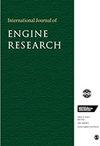双喷射操作对以第二代生物汽油为燃料的火花点火发动机的燃烧性能和颗粒物排放的影响
IF 2.1
4区 工程技术
Q2 ENGINEERING, MECHANICAL
引用次数: 0
摘要
汽车行业必须通过技术解决方案和创新,减少汽车碳排放,促进可持续交通,从而减缓气候变化。生物燃料被视为减少二氧化碳排放的一种解决方案,但可能会影响燃料的性能和排放。事实证明,第二代生物汽油与乙醇混合后,可作为无须添加的燃料使用,其性能和尾气排放与化石燃料相同。然而,颗粒物(PM)排放量明显高于化石燃料。本研究的目的是通过实验研究端口喷射和直接喷射对增压火花点火(SI)发动机中颗粒物排放的影响,与化石燃料基线相比,该发动机使用的是辛烷值为 99、掺有 20% 乙醇的欧 6 标准生物燃料。单缸 SI 发动机配备了两个燃料喷射器(一个直接喷射器和一个端口燃料喷射器),使用外部增压空气运行。为了研究不同发动机负荷和转速下的燃烧特性和颗粒物排放(PM),将分体喷射比从 100% 直接喷射(DI)调整为 100% 端口喷射(PFI)。结果表明,将 100% DI 改为 80% PFI 后,在 4.6 巴 IMEP 的低负荷运行条件下,使用 99 RON E20 生物汽油时,粒径介于 23 纳米和 1000 纳米之间的 PM 排放量减少了 96.56%,使用 95 RON E10 化石燃料时减少了 84%,同时保持了相同的指示热效率和类似的其他排放水平。然而,在超过 10 巴 IMEP 的较高负荷下,全 DI 运行发现,在 20 巴 IMEP 下,99 RON E20 生物汽油和 95 RON E10 矿物燃料的颗粒数(PN)分别减少了 64% 和 38%,并在 3000 转/分钟的较高负荷运行区域实现了更稳定的运行。本文章由计算机程序翻译,如有差异,请以英文原文为准。
Effects of dual injection operations on combustion performances and particulate matter emissions in a spark ignition engine fuelled with second-generation biogasoline
The automotive industry must mitigate climate change by reducing vehicle carbon emissions and promoting sustainable transportation through technical solutions and innovations. Biofuels are seen as a solution to reduce CO2 emissions, but they may affect fuel performance and emissions. Second-generation biogasoline mixed with ethanol has proven that it can be introduced as a drop-in fuel with the same performance and tailpipe emissions at the same level as fossil fuels. However, particulate matter (PM) emissions are significantly higher than fossil fuels. This study aims to experimentally investigate the effect of port and direct fuel injections on the PM emissions in a boosted spark ignition (SI) engine fuelled by Euro 6 standard biofuel with a 99 octane number blended with 20% ethanol compared to a fossil fuel baseline. The single-cylinder SI engine was equipped with two fuel injectors, a direct injector and a port fuel injector, and operated with externally boosted air. The split injection ratio was adjusted from 100% direct injection (DI) to 100% port fuel injection (PFI) to investigate the combustion characteristics and particulate emissions (PM) at different engine loads and speeds. The results indicate that by changing 100% DI to 80% PFI, PM emissions numbers between particle sizes of 23 and 1000 nm were dropped by 96.56% at a low load operation of 4.6 bar IMEP for the 99 RON E20 biogasoline and by 84% for the 95 RON E10 fossil fuel while maintaining the same indicated thermal efficiency and a similar level of other emissions. However, at a higher load above 10 bar IMEP, it was found that full DI operation reduced particulate numbers (PN) by 64% and 38% for 99 RON E20 biogasoline and 95 RON E10 fossil fuel at 20 bar IMEP, respectively, and enabled more stable operation at 3000 rpm with higher load operation regions.
求助全文
通过发布文献求助,成功后即可免费获取论文全文。
去求助
来源期刊

International Journal of Engine Research
工程技术-工程:机械
CiteScore
6.50
自引率
16.00%
发文量
130
审稿时长
>12 weeks
期刊介绍:
The International Journal of Engine Research publishes high quality papers on experimental and analytical studies of engine technology.
 求助内容:
求助内容: 应助结果提醒方式:
应助结果提醒方式:


